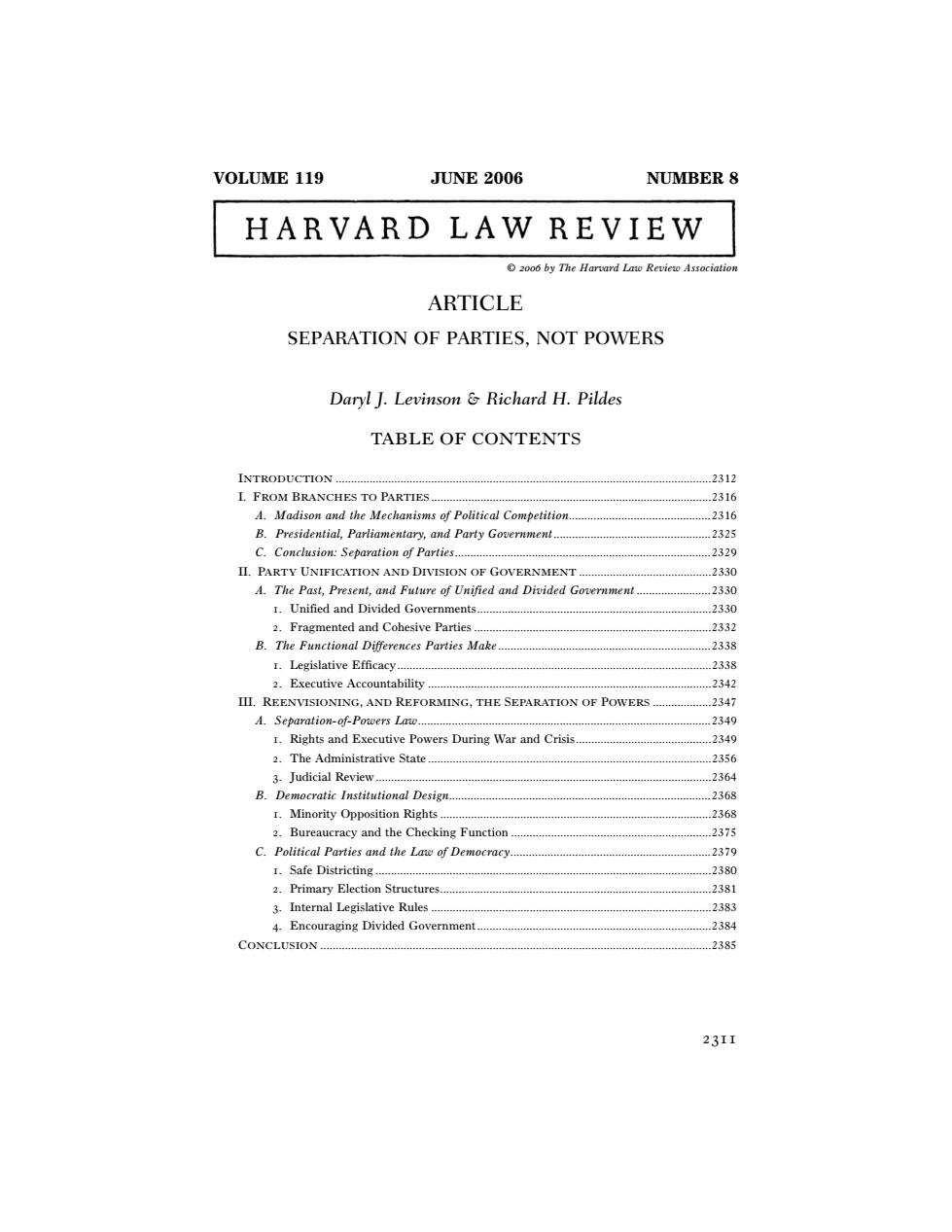正在加载图片...

VOLUME 119 JUNE 2006 NUMBER 8 HARVARD LAW REVIEW 2006 by The Harvard Law Review Association ARTICLE SEPARATION OF PARTIES,NOT POWERS Daryl I.Levinson&Richard H.Pildes TABLE OF CONTENTS INTRODUCTION....... .2312 I.FROM BRANCHES TO PARTIES........... 2316 A.Madison and the Mechanisms of Political Competition316 B.Presidential,Parliamentary,and Party Government....... .2325 C.Conclsion Separation of parties2329 II.PARTY UNIFICATION AND DIVISION OF GOVERNMENT330 A.The Past,Present,and Future of Unified and Divided Government.. .2330 I.Unified and Divided Governments... .2330 2.Fragmented and Cohesive Parties.... .2332 B.The Functional Differences Parties Make................ .2338 I.Legislative Efficacy. .2338 2.Executive Accountability...... 2342 III.REENVISIONING,AND REFORMING,THE SEPARATION OF POWERS....................2347 A.Separation-of-powers Law2349 I.Rights and Executive Powers During War and Crisis............... .2349 2.The Administrative State............. .2356 3 Judicial Review2364 B.Democratic Institutional Design....... .2368 I.Minority Opposition Rights. 2368 2.Bureaucracy and the Checking Function... 2375 C.Political Parties and the Law of Democracy. 2379 L.Safe Districting… 2380 2.Primary Election Structures. 2381 3.Internal Legislative Rules... .2383 4.Encouraging Divided Government 2384 CONCLUSION........ 2385 231I2311 VOLUME 119 JUNE 2006 NUMBER 8 © 2006 by The Harvard Law Review Association ARTICLE SEPARATION OF PARTIES, NOT POWERS Daryl J. Levinson & Richard H. Pildes TABLE OF CONTENTS INTRODUCTION ..........................................................................................................................2312 I. FROM BRANCHES TO PARTIES...........................................................................................2316 A. Madison and the Mechanisms of Political Competition..............................................2316 B. Presidential, Parliamentary, and Party Government ...................................................2325 C. Conclusion: Separation of Parties...................................................................................2329 II. PARTY UNIFICATION AND DIVISION OF GOVERNMENT ...........................................2330 A. The Past, Present, and Future of Unified and Divided Government ........................2330 1. Unified and Divided Governments............................................................................2330 2. Fragmented and Cohesive Parties .............................................................................2332 B. The Functional Differences Parties Make .....................................................................2338 1. Legislative Efficacy......................................................................................................2338 2. Executive Accountability ............................................................................................2342 III. REENVISIONING, AND REFORMING, THE SEPARATION OF POWERS ...................2347 A. Separation-of-Powers Law...............................................................................................2349 1. Rights and Executive Powers During War and Crisis............................................2349 2. The Administrative State ............................................................................................2356 3. Judicial Review.............................................................................................................2364 B. Democratic Institutional Design.....................................................................................2368 1. Minority Opposition Rights ........................................................................................2368 2. Bureaucracy and the Checking Function .................................................................2375 C. Political Parties and the Law of Democracy.................................................................2379 1. Safe Districting .............................................................................................................2380 2. Primary Election Structures........................................................................................2381 3. Internal Legislative Rules ...........................................................................................2383 4. Encouraging Divided Government............................................................................2384 CONCLUSION ...............................................................................................................................2385